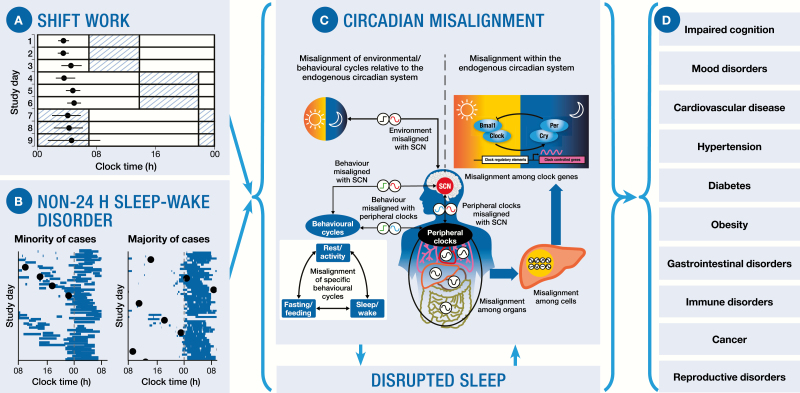Figure 1.
Shift work and Non-24-h Sleep-Wake Disorder have significant implications for adverse clinical health outcomes. (A) Example of shiftwork: behavioral, externally driven circadian misalignment caused by the occupational requirements (adapted from [11]). Blue hatched bars represent work episodes, white bars represent free time or sleep, and filled circles (mean [SE]) represent the peak of melatonin as a marker of central circadian phase. With the change from working day shifts to night shifts, the circadian pacemaker is misaligned with the timing of work and sleep. (B) Examples of N24SWD: a chronic, intrinsically driven circadian disruption. Blue bars represent sleep episodes; filled circles represent the peak of melatonin or cortisol as markers of central circadian phase. The left panel illustrates what most clinicians consider is the typical manifestation of N24SWD, however, only a small proportion maintain entrainment between circadian and sleep cycles. The right panel illustrates that most patients are either not diagnosed or misdiagnosed (e.g. insomnia); because they do not present with a non-24-h sleep-wake profile (adapted from [12]). Circadian phase assessments are rarely conducted to confirm diagnoses. (C) The molecular mechanism generating endogenous circadian rhythms consists of intracellular transcriptional/translational positive and negative feedback loops involving a complex clock-gene regulatory network, of which only one core feedback loop is displayed here for simplicity. Shift work and N24SWD both lead to circadian misalignment and (consequential) sleep disruption. Circadian misalignment often manifests between behavioral and environmental cycles and the central pacemaker in the SCN and between behavioral and peripheral circadian oscillators found in virtually every organ and cell of the body. Internal desynchrony occurs between peripheral oscillators and the SCN, and among organs, cells and clock genes (adapted from [1]). (D) Circadian misalignment and sleep disruption have been implicated in numerous adverse health outcomes.

